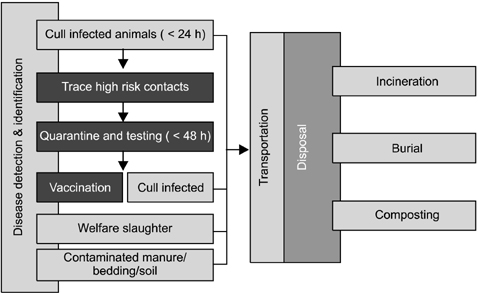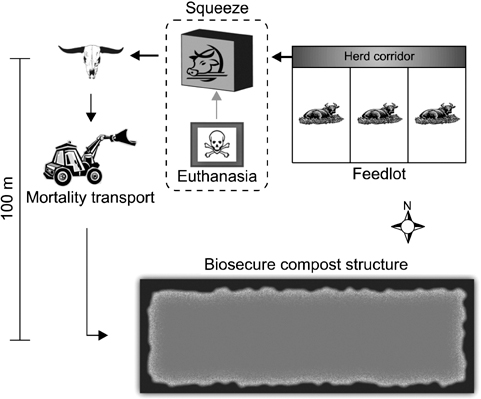J Vet Sci.
2013 Mar;14(1):103-106. 10.4142/jvs.2013.14.1.103.
Emergency euthanasia of cattle challenged with Escherichia coli O157:H7 - A case study for evaluating the response to an infectious disease outbreak
- Affiliations
-
- 1School of Environmental Sciences, University of Guelph Ridgetown Campus, Ontario, Canada N0P 2C0.
- 2Agriculture and Agri-Food Canada, Lethbridge Research Centre, Alberta, Canada T1J 4B1. tim.mcallister@agr.gc.ca
- KMID: 1482821
- DOI: http://doi.org/10.4142/jvs.2013.14.1.103
Abstract
- In the event of an infectious disease outbreak in cattle, carcasses must be disposed of in a rapid and contained manner. This brief communication details injection of a barbiturate to euthanize cattle inoculated with Escherichia coli O157:H7 followed by carcass composting in a manner that prevents the spread of infectious agents.
Keyword
MeSH Terms
-
Animals
Cattle
Cattle Diseases/*microbiology
Disease Outbreaks/*veterinary
Escherichia coli Infections/microbiology/*veterinary
*Escherichia coli O157
Euthanasia, Animal/*methods
Hypnotics and Sedatives/administration & dosage/pharmacology
Male
Pentobarbital/administration & dosage/*pharmacology
Soil
Hypnotics and Sedatives
Soil
Pentobarbital
Figure
Reference
-
1. Dunn MV. The threat of bioterrorism to U.S. agriculture. Ann NY Acad Sci. 1999. 894:184–188.
Article2. Galvin JW, Blokhuis H, Chimbombi MC, Jong D, Wotton S. Killing of animals for disease control purposes. Rev Sci Tech. 2005. 24:711–722.3. Gerber P, Chilonda P, Franceschini G, Menzi H. Geographical determinants and environmental implications of livestock production intensification in Asia. Bioresour Technol. 2005. 96:263–276.
Article4. Reuter T, Xu W, Alexander TW, Gilroyed BH, Inglis GD, Larney FJ, Stanford K, McAllister TA. Biocontained carcass composting for control of infectious disease outbreak in livestock. J Vis Exp. 2010. 39:e1946.
Article5. The European Union. Council Regulation (EC) No 1099/2009 of 24 September 2009 on the protection of animals at the time of killing. Off J Eur Union. 2009. 52:1–30.6. Whiting TL. Foreign animal disease outbreaks, the animal welfare implications for Canada: risks apparent from international experience. Can Vet J. 2003. 44:805–815.7. World Organisation for Animal Health. Terrestrial Animal Health Code. 2006. 15th ed. Paris: OIE;475–496.
- Full Text Links
- Actions
-
Cited
- CITED
-
- Close
- Share
- Similar articles
-
- Detection of Escherichia coli O157 and Escherichia coli O157:H7 by the immunomagnetic separation technique and stx1 and stx2 genes by multiplex PCR in slaughtered cattle in Samsun Province, Turkey
- All blood, No stool: enterohemorrhagic Escherichia coli O157:H7 infection
- Escherichia coli O157: H7 Infection
- An outbreak of inapparent non-O157 enterohemorrhagic escherichia coli infection
- Antibacterial effects of carvacrol against Staphylococcus aureus and Escherichia coli O157:H7





